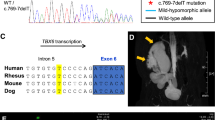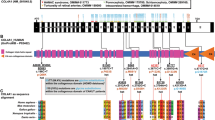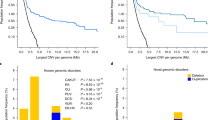Abstract
Background
Mutations in human SIX1 gene cause branchiootorenal or branchiootic syndrome. Six1 deficient mice exhibit uni- or bilateral renal hypoplasia or kidney agenesis. Furthermore a lack of Six1 gene in the ureter leads to hydroureter and hydronephrosis. These murine malformations resemble human kidney and urinary tract congenital anomalies (CAKUT), a group of diseases with a diverse anatomical spectrum which includes duplex collecting system as much as urethra kidney and ureteropelvic anomalies. Our study focuses on whether mutations or deletion of this gene may be associated with nonsyndromic CAKUT.
Methods
Fifty unrelated patients (13–21 years) with nonsyndromic CAKUT were retrospectively recruited for SIX1 sequence variations analysis, and compared to three subjects without malformative nephrouropathies (controls). SIX1 coding sequence was screened by high resolution melt analysis (HRMA) and by Sanger direct sequencing. A quantitative comparative real-time polymerase chain reaction (PCR) was later performed in order to detect the presence of SIX1 gene deletion.
Results
We did not find significant differences in the HRMA melting curves for each of the SIX1 coding exons between patients and controls, as also confirmed by Sanger direct sequencing. Moreover quantitative comparative real-time PCR for SIX1 and data normalization excluded total SIX1 gene deletion in our patients.
Conclusions
We did not find sequence variations in SIX1 coding regions or complete gene deletion in our CAKUT population. These results suggest that alterations in these sequences are unlikely to be a major cause of nonsyndromic CAKUT. Nevertheless, further studies are necessary to understand if altered SIX1 expression may play a role in human development of kidney and urinary tract congenital anomalies.

Similar content being viewed by others
References
Ohto H, Takizawa T, Saito T, Kobayashi M, Ikeda K, Kawakami K (1998) Tissue and developmental distribution of six family gene products. Int J Dev Biol 42(2):141–148
Noguchi Y, Ito T, Nishio A, Honda K, Kitamura K (2011) Audiovestibular findings in a branchio-oto syndrome patient with a SIX1 mutation. Acta Otolaryngol 131(4):413–418
Nie X, Xu J, El-Hashash A, Xu PX (2011) Six1 regulates Grem1 expression in the metanephric mesenchyme to initiate branching morphogenesis. Dev Biol 352(1):141–151
Nie X, Sun J, Gordon RE, Cai CL, Xu PX (2010) SIX1 acts synergistically with TBX18 in mediating ureteral smooth muscle formation. Development 137(5):755–765
Xu PX, Zheng W, Huang L, Maire P, Laclef C, Silvius D (2003) Six1 is required for the early organogenesis of mammalian kidney. Development 130(14):3085–3094
Dressler GR (2006) The cellular basis of kidney development. Annu Rev Cell Dev Biol 22:509–529 (Review)
Costantini F (2006) Renal branching morphogenesis: concepts, questions, and recent advances. Differentiation 74(7):402–421 Review
Shah MM, Sampogna RV, Sakurai H, Bush KT, Nigam SK (2004) Branching morphogenesis and kidney disease. Development 131(7):1449–1462 (Review)
Nakanishi K, Yoshikawa N (2003) Genetic disorders of human congenital anomalies of the kidney and urinary tract (CAKUT). Pediatr Int 45(5):610–616
Ruf RG, Xu PX, Silvius D et al (2004) SIX1 mutations cause branchio-oto-renal syndrome by disruption of EYA1–SIX1–DNA complexes. Proc Natl Acad Sci USA 101(21):8090–8095
Krug P, Morinière V, Marlin S et al (2011) Mutation screening of the EYA1, SIX1, and SIX5 genes in a large cohort of patients harboring branchio-oto-renal syndrome calls into question the pathogenic role of SIX5 mutations. Hum Mutat 32(2):183–190
Izzedine H, Tankere F, Launay-Vacher V, Deray G (2004) Ear and kidney syndromes: molecular versus clinical approach. Kidney Int 65(2):369–385 (Review)
Kobayashi H, Kawakami K, Asashima M, Nishinakamura R (2007) Six1 and Six4 are essential for Gdnf expression in the metanephric mesenchyme and ureteric bud formation, while Six1 deficiency alone causes mesonephric-tubule defects. Mech Dev 124(4):290–303
Dinkel E, Ertel M, Dittrich M, Peters H, Berres M, Schulte-Wissermann H (1985) Kidney size in childhood. Sonographical growth charts for kidney length and volume. Pediatr Radiol 15(1):38–43
Han BK, Babcock DS (1985) Sonographic measurements and appearance of normal kidneys in children. Am J Roentgenol 145(3):611–616
Harmon DL, Shields DC, Woodside JV et al (1999) Methionine synthase D919G polymorphism is a significant but modest determinant of circulating homocysteine concentrations. Genet Epidemiol 17(4):298–309
Yu J, McMahon AP, Valerius MT (2004) Recent genetic studies of mouse kidney development. Curr Opin Genet Dev 14(5):550–557
Kochhar A, Orten DJ, Sorensen JL et al (2008) SIX1 mutation screening in 247 branchio-oto-renal syndrome families: a recurrent missense mutation associated with BOR. Hum Mutat 29(4):565–577
Ruf RG, Berkman J, Wolf MT et al (2003) A gene locus for branchio-otic syndrome maps to chromosome 14q21.3-q24.3. J Med Genet 40(7):515–519
Sanggaard KM, Rendtorff ND, Kjaer KW et al (2007) Branchio-oto-renal syndrome: detection of EYA1 and SIX1 mutations in five out of six Danish families by combining linkage, MLPA and sequencing analyses. Eur J Hum Genet 15(11):1121–1131
Ozaki H, Watanabe Y, Ikeda K, Kawakami K (2002) Impaired interactions between mouse Eya1 harboring mutations found in patients with branchio-oto-renal syndrome and Six, Dach, and G proteins. J Hum Genet 47(3):107–116
Patrick AN, Schiemann BJ, Yang K, Zhao R, Ford HL (2009) Biochemical and functional characterization of six SIX1 branchio-oto-renal syndrome mutations. J Biol Chem 284(31):20781–20790
Vivante A, Mark-Danieli M, Davidovits M et al (2013) Renal hypodysplasia associates with a WNT4 variant that causes aberrant canonical WNT signaling. J Am Soc Nephrol 24(4):550–558
Saisawat P, Tasic V, Vega-Warner V et al (2012) Identification of two novel CAKUT-causing genes by massively parallel exon resequencing of candidate genes in patients with unilateral renal agenesis. Kidney Int 81(2):196–200
Saisawat P, Kohl S, Hilger AC et al (2013) Whole-exome resequencing reveals recessive mutations in TRAP1 in individuals with CAKUT and VACTERL association. Kidney Int. doi:10.1038/ki.2013.417
Sanna-Cherchi S, Sampogna RV, Papeta N et al (2013) Mutations in DSTYK and dominant urinary tract malformations. N Engl J Med 369(7):621–629
Weber S, Moriniere V, Knüppel T et al (2006) Prevalence of mutations in renal developmental genes in children with renal hypodysplasia: results of the ESCAPE study. J Am Soc Nephrol 17(10):2864–2870
Hwang DY, Dworschak GC, Kohl S et al (2014) Mutations in 12 known dominant disease-causing genes clarify many congenital anomalies of the kidney and urinary tract. Kidney Int. doi:10.1038/ki.2013.508
Wu W, Ren Z, Liu H et al (2013) Core promoter analysis of porcine Six1 gene and its regulation of the promoter activity by CpG methylation. Gene 529(2):238–244
de Vooght KM, van Wijk R, van Solinge WW (2009) Management of gene promoter mutations in molecular diagnostics. Clin Chem 55(4):698–708. doi:10.1373/clinchem.2008.120931
Conflict of interest
On behalf of all authors, the corresponding author states that there is no conflict of interest.
Author information
Authors and Affiliations
Corresponding author
Electronic supplementary material
Below is the link to the electronic supplementary material.
Rights and permissions
About this article
Cite this article
Negrisolo, S., Centi, S., Benetti, E. et al. SIX1 gene: absence of mutations in children with isolated congenital anomalies of kidney and urinary tract. J Nephrol 27, 667–671 (2014). https://doi.org/10.1007/s40620-014-0112-x
Received:
Accepted:
Published:
Issue Date:
DOI: https://doi.org/10.1007/s40620-014-0112-x




